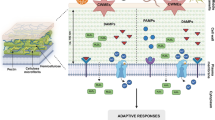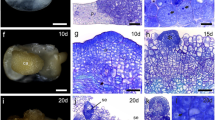Abstract
The stigma of Kigelia pinnata is spathulate, wet and sensitive to touch. Consisting of two flaps or folds, the inner surface of these stigmatic flaps is papillate. Covered by a prominent papillar zone, each papilla contains lipid and phenolic deposits which remain entrapped below the thick cuticle till the stigma attains receptivity. Gradual unfolding of stigmatic flaps; about 1 h post anthesis, marks the beginning of stigma receptivity. Reaching a peak at 24 h after anthesis, the stigma remains receptive for 48 h. Papillae gradually lose turgidity after 72 h post anthesis and liberate their contents into the outside medium. During this time, stigma receptivity declines sharply as can be made out from the germination of only 10% pollen. Thereafter, none of the pollen deposited on the stigma germinates. The papillar phenology exhibits a close coordination with stigma receptivity indicating that both the processes are proportionately related to each other. Therefore, evaluation of papillar integrity can be used as a quick method to check stigma receptivity in K. pinnata.





Similar content being viewed by others
References
Kulloli SK, Ramasubbu R, Sreekala AK, Pandurangan AG (2010) Cytochemical localization of stigma surface esterases in three species of Impatiens (Balsaminaceae) of Western Ghats. Asian J Exp Biol Sci 1:106–111
Heslop-Harrison Y, Shivanna KR (1977) The receptive surface of the angiosperm stigma. Ann Bot 41:1233–1258
Heslop-Harrison J, Heslop-Harrison Y (1985) Surfaces and secretions in the pollen-stigma interaction: a brief review. J Cell Sci Suppl 2:287–300
Slater AT, Calder DM (1990) Fine structure of the wet, detached cell stigma of the orchid Dendrobrium speciosum Sm. Sex Plant Reprod 3:61–69
Kenrick J, Knox RB (1981) Post pollination exudate from stigmas of Acacia (Mimosaceae). Ann Bot 48:103–106
Nasrallah JB, Nasrallah ME (1993) Pollen-stigma signalling in the sporophytic self-incompatibility response. Plant Cell 5:1325–1335
Gonzalez MV, Coque M, Herrero M (1995) Papillar integrity as an indicator of stigma receptivity in kiwifruit (Actinidia deliciosa). J Exp Bot 46:263–269
Ghose S, Shivanna KR (1984) Structure and cytochemistry of the stigma and pollen-pistil interaction in Zephyranthus. Ann Bot 53:91–105
Gentry AH (1976) Relationships of the Madagascar Bignoniaceae: a striking case of convergent evolution. Plant Syst Evolut 126:255–266
Raina M (2013) Morpho-anatomical studies of pistil with emphasis on the type of self-incompatibility in Kigelia pinnata (Jacq.) DC. Dissertation, University of Jammu
Raina M, Kumar R, Kaul V (2017) Stigmatic limitations on reproductive success in a paleotropical tree: causes and consequences. AoB Plants 9:plx023. https://doi.org/10.1093/aobpla/plx023
Benes K (1968) On the stainability of pollen cell walls with alcian blue. Biolia Plant 10:334–347
Feder N, O’Brien TP (1968) Plant microtechniques: some principles and new methods. Am J Bot 55:123–142
Krishnamurthy KV (1999) Methods in cell wall cytochemistry. CRC Press, Boca Raton
Heslop-Harrison J, Heslop-Harrison Y, Knox RB, Howlett B (1973) Pollen wall proteins: gametophytic and sporophytic fractions in the pollen wall of the Malvaceae. Ann Bot 37:403–412
Shivanna KR, Rangaswamy NS (1992) Pollen biology—a laboratory manual. Narosa Publishing House, New Delhi, pp 45–47
Martin FW (1970) Compounds of the stigmatic surface of Zea mays L. Ann Bot 34:835
Heslop-Harrison Y (1981) Stigma characteristics and angiosperm I, taxonomy. Nord J Bot 1:401–420
Szember E, Wocior S (1991) Influence of flavanoids and other phenolic compounds on pollen germination and growth of the pollen tube. Fruit Sci Rep 28:85–90
Nicholson RL, Hammerschmidt R (1992) Phenolic compounds and their role in disease resistance. Annu Rev Phytopathol 30:369–389
Stpiczynska M (2003) Stigma receptivity during the life span of Platanthera chlorantha Custar (Rchib.) flowers. Acta Biol Crac Ser Bot 45/1:37–41
Kandasamy MK, Thorsness MK, Rundle SJ, Goldberg ML, Nasrallah JB, Nasrallah ME (1993) Ablation of papillar cell function in Brassica flowers results in the loss of stigma receptivity to pollination. Plant Cell 5:263–275
Galen C, Shykoff JA, Plowright RC (1986) Consequences of stigma receptivity schedules for sexual selection in flowering plants. Am Soc Nat 127:462–476
Cresti M, Tiezzi A (2011) Sexual plant reproduction. Springer, Berlin
Fahn A (1988) Secretory tissue in vascular plants. New Phytol 108:229–257
Rana A (2009) Morphological differences in the stigma of fruit bearing and fruitless plants of Kigelia pinnata DC. (Bignoniaceae). J Plant Reprod Biol 1(1):43–48
Verma S, Magotra R, Koul AK (2001) Insect induced anther dehiscence, pollination and maximization of maternal rewards. In: Ganeshaiah KN, Uma Shanker R, Bawa KS (eds) Tropical ecosystems: structure, diversity and human welfare. Oxford and IBH, New Delhi, pp 211–213
Acknowledgements
One of the authors acknowledges the award of Junior Research Fellowship (No. DST/INSPIRE Fellowship/2014/124) by the Department of Science and Technology (DST), INSPIRE, New Delhi. The authors thank the Head, Department of Botany, University of Jammu, Jammu for providing the necessary library and laboratory facilities. They also acknowledge Mr. Ishwar Singh for his assistance in the field work.
Author information
Authors and Affiliations
Corresponding author
Ethics declarations
Conflict of interest
The authors declare no conflict of interest to publish this manuscript.
Additional information
Significance statement This is the first ever comprehensive study of the patterns of stigma receptivity and fundamentals of papillar phenology in K. pinnata. This article provides a novel method to check stigma receptivity instantly; without using the conventional methods.
Rights and permissions
About this article
Cite this article
Raina, M., Kaul, V. Assessment of stigma receptivity via papillar integrity in Kigelia pinnata (Bignoniaceae). Proc. Natl. Acad. Sci., India, Sect. B Biol. Sci. 89, 867–875 (2019). https://doi.org/10.1007/s40011-018-0999-4
Received:
Revised:
Accepted:
Published:
Issue Date:
DOI: https://doi.org/10.1007/s40011-018-0999-4




